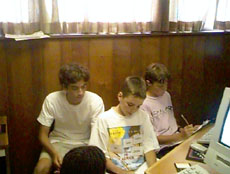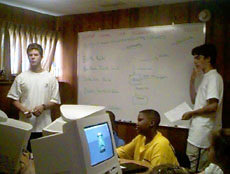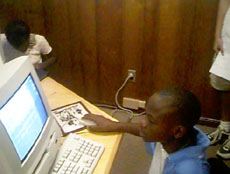|
July 17, 1997 As the students left the Foundation today, only two more sessions remained for this year's Internet Explorers Club program. This particular class had one of those sessions claimed for tomorrow, but today was their real concern. Forging through computational modeling and once again facing Dr. Panoff's inquiries into observation, the students grasped a wide range of modern technological knowledge. Joe South, the IEC program director, opened the day in his typical manner with a recap of all the week's past activities. Among those items that Joe mentioned were the use of collaborative tools, on-line modeling, Internet skills, and observation skills. Paying particular attention to the previous day's exercise with Dr. Panoff (Bob1), Joe highlighted IEC's six buzz words: Noise, Signal, Data, Information, Knowledge, and Truth.
Once Joe was completed, Shodor intern Tom Dietz returned to finish the previous day's on-line modeling program. Students worked diligently to complete their Population Dynamics Model. Some students were even able to continue working on the Flu Epidemic Model, but eventually Tom broke down the Population Dynamics model in a quick review. Highlighting the populations of four countries, Rwanda, Jordan, Germany, and The Netherlands, Tom asked the students to consider the nation's populations. The students seemed amazed by Rwanda's huge birth and death rates, which Tom explained were common among undeveloped nations. Of equal amazement to the students was the fact that Germany's population was decreasing. Tom, elaborating on the fact that Germany's population was decreasing, asked students to consider factors that might cause a population to decrease. The students responded with war, plaque, poor sanitary conditions, poor economics, inflation, and unusual birth cycles. Tom explained that none of these conditions really caused the low birth rates, since Germany is a well developed nation with tremendous economic strength. Instead the population was decreasing simply because families were choosing to have fewer children. Continuing this idea, Tom explained that nations with great economic prosperity often had low birth rates because it is both socially and economically advantageous for the family as a whole.
Elaborating on the failures of models, Joe South explained that "sometimes models are used that have some of the information necessary, but not all of it." By this, Joe was a stressing a point Tom was trying to make--that models have limitations and cannot ever adequately reflect reality. Moving on, Bob1 showed the students how looks are often deceiving. Using drinking straw boxes, resealed from earlier in the day, students were asked to count the number of straws in a box. The students then counted the boxes and received anywhere from 52 to 53 straws per box. This was, however, inconsistent with the label's claim that their was 50 straws in a box. Upon proving this, Bob1 explained that therewere 50 straws in a box, along with a couple more. The label wasn't wrong--just misleading. To further this understanding, Bob1 had the students measure the lengths of the straws in the box in order to compare them, again, to the box labels. The students found that the information was close, but not completely accurate since each straw was different from the other straws. Bob1 then asked "What does it mean to be squash-proof?" The boxes claimed that the straws were squash-proof, yet all the students agreed that anyone could squash a straw if they really wanted to. The point of the exercise was well-learned when Bob1 summed up the reality of the situation. "If [the facts] really mattered you would have to really check [the facts]," continuing the idea that just because something looks right it does not mean it is right. "You have to think: are they using the numbers in the same way [I'm] using the numbers," stated Bob1, wrapping up his message. Bob1 used the example of medical prescriptions in which true precision and accuracy is needed in order to avoid assigning a fatal prescription. Compared to a life-and-death situation the point that informatin can be misleading really struck home to the students. Next, Bob1 had Ian, a Shodor student, read a paper aloud to the class. After having done so, Bob1 explained that his reading was wrong. Alicia, another student, then read the message and made the same error. What they were doing wrong was reading a message with two thes as only one the: "I have never seen anything so lively as Paris in the the spring." Bob1 rationalized this error by stating that "you think you've seen this or you think you are familiar with this, but the truth is that you're programmed to think a certain way." By this Bob1 meant to say that the students were thinking and observing in a particular way, but were wrong to do it this way. The students, therefore, must correct this error by unlearning what they have learned and rethinking the way they think. Next the students completed one more exercise with Bob1--the telephone game. Again, the students failed to recognize that the words were moving in a particular pattern, and as such failed to see how easy the message was to transfer. The message, "apple boat cow dog egg fog goat happy" was alphabetic, but the students failed to see this and therefore forgot several of the words in the cycle.
Returning indoors, Shodor interns Andy Hebrank and Jonathan Pahl introduced the Explorers to their next task: helping to build a computer model of an Ebola outbreak. After briefly discussing the disease, Andy outlined the basic structure of the model. He identified the rates involved in determining the length and seriousness of an outbreak, and then asked students to search for the information on the Internet. The students quickly discovered birth and death rates for the country where the outbreak occurred, and the infection and mortality rates of Ebola during that outbreak. Explorers will use their own rates tomorrow to simulate an outbreak with a STELLA® model prepared in advance. Now the students have only one more class before this session of the IEC officially comes to an end. Then they will have only their memories and newfound knowledge, but hopefully they will continue to take their knowledge with them into their futures. ESS>Last Update: June 14, 1999 Please direct questions and comments about this page to WebMaster@shodor.org © Copyright 1998 The Shodor Education Foundation, Inc. |







